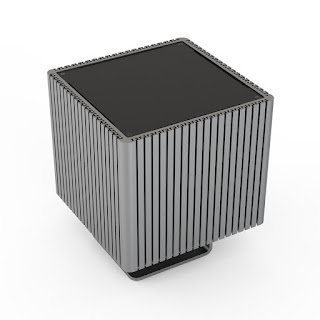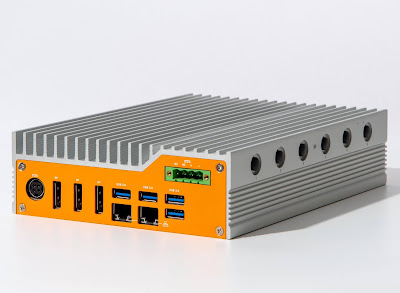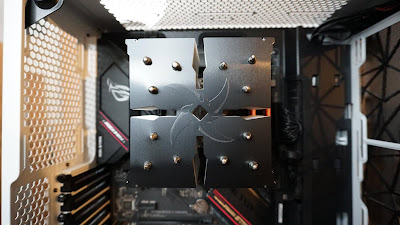12.30.2020
12.29.2020
Azulle Byte4 review
"Removing the four board mounting screws allows us to peel back the final layer, looking for that patented heat spreading design. Ah, there it is. The entire top of the case is a sheet of metal with a slug extended towards the cpu. The entire board mounting action essentially clamps the CPU to the interior metal “roof”, which has a very generous amount of gooey thermal paste.
The Azulle Byte4 is probably not a device I would place in my home personally, but I can see where it has definite business applications and I would consider giving one to certain people as a gift as I think they could get a lot of use out of one. It’s a great device if you have the requirement to run a dedicated PC / Windows (or perhaps Linux?) application as more of an appliance rather then a general purpose computer."
Source: PC Perspective
12.28.2020
Titanium DB4 available
Streacom's flagship case is now available in Titanium. The DB4 measures 260 x 260 x 270mm but still manages to accommodate an ITX motherboard, a dual-slot full-height PCI card (max 200mm length, 110mm height), up to 5 x 3.5” or 12 x 2.5” drives (lots of combinations in between), and can be powered by the Streacom Nano or ZeroFlex PSU solutions. The 18-liter aluminum cube handles 65W CPUs (expandable to 110W using the LH6 heatpipes kit).
12.25.2020
FIRST LOOK: Akasa Turing A50
Here's your first look at the Akasa Turing A50, designed to passively cool the NUC-size ASUS PN50 mini PC. Powered by the latest AMD Ryzen 4000 Series with Radeon Vega 7 graphics, the ASUS A50 supports up to 4 displays simultaneously with 4K resolution, 8K UHD at 60Hz through DisplayPort dual-mode, dual USB 3.2 Gen 2 Type-C with DisplayPort functionality, and 24/7 reliability. The Turing A50 retains the same dimensions as the original Turing and will be available in February.
12.24.2020
Fanless LarkBox (DIY)
The CHUWI LarkBox is an incredibly small and incredibly noisy computer, given its size. Powered by a 10W Gemini Lake processor the mini desktop can be passively cooled using the 15-year-old Zalman ZM-NB47J chipset heat sink. The cooler brings a certain flare to a rather boring box and keeps the CPU from throttling, even under heavy load.
Source: Hydrosaure
12.23.2020
Top 10 advantages of the Helix Series and its Intel 10th Gen Processing
Built better from the ground up with 10th gen architecture
Intel’s architecture updates offer many enhancements including improved heat dissipation. Bottom line, the systems are easier to keep cool. So even with high processing power, Helix offers an extended operating temperature range from 0°C to 50°C.
Long lifecycle for your IIoT project
This brand new architecture has a long lifecycle which offers peace of mind. This means you can source and deploy additional or identical replacement hardware as needed for the lifespan of your application.
Enhanced integrated graphics
With Helix, you can have up to 3 independent 4K displays, all without a dedicated graphics card which can create excessive heat.
Maximum performance capabilities
Helix supports up to 64 GB of RAM. The end result is that you don’t have to compromise performance.
Right performance at the right cost
Helix can be configured with as few as 2 Cores and as many as 10 Cores, with up to 20 threads. Consequently, you can choose the performance that works best for you. You don’t have to pay for more than what you need.
Connectivity in abundance
Helix offers a huge variety of I/O, including 8 USB ports and options for your legacy connection needs.
Limit downtime with Intel vPro technology, including Intel Active Management Technology (AMT)
Downtime will be limited and Out-Of-Band (OOB) features are made easy with Intel AMT. As a result, technicians can remotely manage systems, thereby eliminating costly visits for field maintenance.
Reap the benefits of virtualization
Create a faithful abstraction of the full 10th gen Comet Lake processor to a Virtual Machine. By taking advantage of virtualization, you could save money on hardware, power and IT staff costs.
Improved performance and reliability
Use Intel RST to help solve complex storage challenges for applications that need speed or redundancy. Consequently, this might help to protect you from data loss.
Customize power needs with configurable TDP
With configurable TDP, you can decide what wattage to run. That means, if you don’t need the power, you can scale down and save on power consumption.
12.22.2020
Genius idea
Thanks to this pretty smart NUC case / CPU mounting kit, cooling the Intel mini PC using a regular CPU cooler has never been easier. The metal chassis features a copper heat spreader and four mounting holes for LGA 115x CPU coolers. This is absolutely genius and we would gladly support - and even promote - such a product from a reliable brand.
Source: gaojitui
12.21.2020
EXCLUSIVE: Noctua's fanless cooler
Here's an exclusive look at Noctua's upcoming passive CPU cooler. Its final design is slightly different from the Computex 2019 prototype, with maybe thinner cooling fins and more perforations. Definitely our most anticipated product of 2021. Stay tuned.
12.18.2020
PrimeMini 4 on sale
The trusty fanless PC from Switzerland is now available 18% off. The Kaby Lake / Kaby Lake Refresh mini desktop (i3-7100U, i5-7300U, and i7-8650U options available) is fully configurable with up to 3TB of SSD storage. PrimeMini 4 features four USB 3.0 ports, two HDMI 2.0 ports, and one RJ45/LAN port. Ubuntu installation is also a nice touch.
Source: Prime Computer
12.17.2020
Fixing poor cooling
The ZBOX CI320 nano is powered by a passively-cooled Celeron N2930, a 7.5W TDP Bay Trail processor. The diminutive PC launched in 2014 but was plagued by heat problems. Just looking at the weird and convoluted cooling solution makes us uncomfortable. The small internal heat sink suffocates inside a not-so-convection-friendly chassis. Simply adding a stock Intel cooler on top of the thermal pad and ditching the case fixes everything.
Source: gaojitui
12.16.2020
12.15.2020
NUC Elements real-life pictures
We do not believe in modular computing, especially for low-power systems, and especially if soldered RAM and storage are involved. Modularity - and freedom - start with memory and storage. Any other solution is user-hostile in our books. That said, this KoolShare member seems pretty happy with his rugged Austin Beach chassis and Celeron 4305U-powered Chandler Bay Compute Element. The slim computer also features 4GB RAM and 64GB of eMMC storage.
Source: KoolShare
12.14.2020
12.11.2020
Akasa Maxwell Pro now i9 compatible
12.10.2020
ZBOX CI341 available as a complete PC
The ZBOX edge CI341 features the 6W Celeron N4100, two SO-DIMM slots, M.2 storage, DisplayPort 1.4 and HDMI 2.0, three USB ports, two Gigabit Ethernet ports, SD card reader, WiFi and Bluetooth. The slim 147.2 x 147.2 x 32.1mm (5.80 x 5.80 x 1.26in) system is now available as a complete Windows 10 Pro PC featuring a paltry 4GB RAM and a disappointingly small 64GB M.2 SSD. Definitely get the $180 barebone and add your own SSD for something more functional.
Source: ZOTAC
12.09.2020
PCMag reviews the ZBOX CI341
"Zotac's goal for its ZBox Edge CI341 ($179.99 as tested, in bare-bones form) was to create an exceedingly compact mini PC that's entirely silent and fit for everyday use, plus some niche cases. Those include audiophiles seeking zero distraction from their PC platform; display-signage deployment; and, as the name implies, edge-computing scenarios requiring minimal local processing power. The company succeeds on the first ("compact") front—the Edge is tiny and, with no cooling fans or other moving parts, noiseless. The Intel Celeron-based micro desktop's performance may be a different matter, but the CI341 has at least a few no-doubter things going for it, including solid build quality and a low starting cost. Whether it has enough else to succeed beyond a few limited applications, among some competing devices that cost about the same once this ZBox is fully equipped with components, will be up to you, and what you do. As it stands, it's solid for what it is, but don't expect major muscle."
Source: PCMag
12.08.2020
The best fanless CPU cooler showdown 2
12.07.2020
12.04.2020
Tranquil Rugged Server available
The Tranquil Rugged Server (RS-XDS-50) is designed with a half rack form factor to collect and process data. Powered by Intel's Xeon D1521 processor (4 Cores/8 Threads, up to 2.7GHz, 6MB cache, 45W TDP) or Intel's Xeon D1541 processor (8 Cores/16 Threads, up to 2.7GHz, 12MB cache, 45W TDP), the RS has 128GB RAM, remote management, and up to 10GbE LAN. The 75 x 221 x 335.5mm aluminum chassis is IP50-rated and designed to resist shocks and vibrations.
Source: Tranquil
12.03.2020
12.02.2020
Comet Lake incus available
Originally designed for ASRock's AMD-based DeskMini (pictured next to the smaller NUC-based nimbini), cirrus7's mini-STX system is now compatible with Intel's desktop Comet Lake processors. The diminutive (202 x 179 x 148mm) but heavy (4.5kg) system is fully configurable and handles 65W CPUs up to the mighty i9-10900.
Source: cirrus7



















































